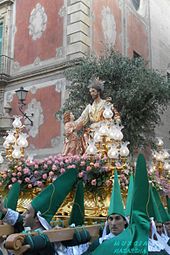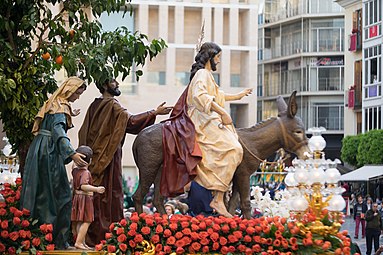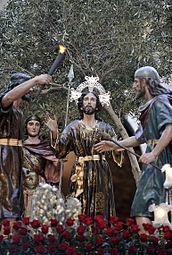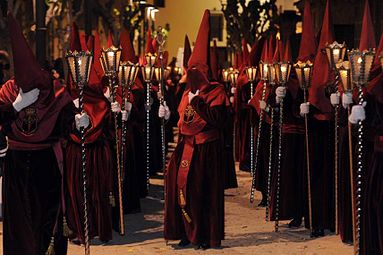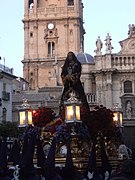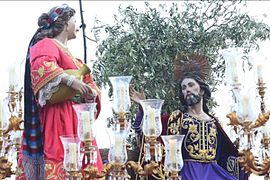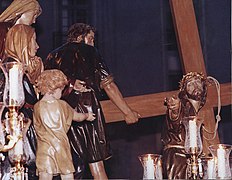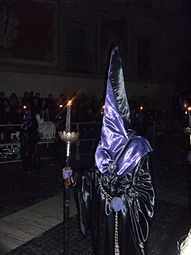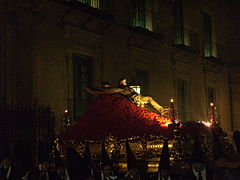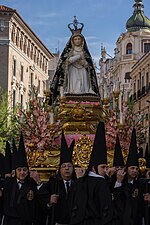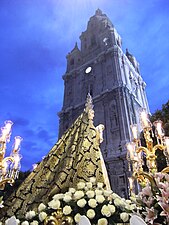Holy Week in Murcia
The Holy Week in Murcia is a religious festival declared of International Tourist Interest that takes place every year between Friday of Dolores and Easter Sunday in the city of Murcia (Spain).
This is one of the most important Spanish Holy Weeks both for its excellent sculptural heritage; highlighting the carvings of Francisco Salzillo (XVIII century), as well as those of Diego de Ayala and Domingo Beltrán ( ="font-variant:small-caps;text-transform:lowercase">XVI), Nicholas de Bussy (XVII century) ), Antonio Dupar, Nicolás Salzillo and Roque López (18th century), and contemporaries Juan González Moreno, José Planes or José Hernández Navarro, as well as having its own style (the traditional style) originating from the 18th century and which is a unique way in Spain to celebrate passion, which makes it a special holy week on the national scene by escaping the omnipresent Andalusian influence (whether from Seville or Malaga) and also distinguishing itself from the castel style lano, thus constituting a very important ethnographic heritage.
It is also the oldest celebration in the city since the oldest brotherhood, Los Coloraos, has its roots in the beginning of the century XV.
Easter Week in Murcia was declared of International Tourist Interest on April 5, 2011.
Brotherhoods and styles
Currently, there are 15 Murcian brotherhoods that are in charge of taking out 95 thrones or processional steps to the streets every Holy Week with their respective brotherhoods, and it is that in Murcia, as a peculiar feature, each processional step forms a brotherhood, constituted for the penitent Nazarenes and the estantes (those who carry the throne); since the 95 steps are carried on shoulders. In this way, each of the 15 brotherhoods is made up of different brotherhoods, from the only brotherhood of the Cofradía del Refugio (el Silencio), to the 14 brotherhoods of Los Coloraos (divided between its two processions, 11 on Holy Wednesday and 3 on Holy Thursday).
These 15 brotherhoods take to the streets a total of 17 processions.
The processions take place in the afternoon or at night (departing between 5:00 p.m. and 10:00 p.m.), except on Good Friday (6:00 a.m. solar time) and Easter Sunday (8:15 a.m. h.), days in which there are processions in the morning.
Likewise, it is a Holy Week full of nuances and very diverse, since it enjoys two different styles of processions, one of them totally exclusive to Murcia:
The traditional style
- It is the oldest, it plunges its roots in the centuryXVIII, characterized by the special shelves (nazarenes carrying the steps) and butler (Nazarene who govern the procession). Both carry a capuz (a murcian form of calling the capirote) short and romo that does not have the usual conical shape of the rest of Spain and that leaves the face uncovered, counting on some silk ribs on both sides that today have a decorative function but that in ancient times served to adjust the capuz under the chin. In addition, the shelves wear the tunic collected in the waist forming a buche (or "sena", as it is said in Murcia) that leaves the robe slightly below the knee. Under that "faldilla" they take starch water that flies the robe. Finally they heat up orchards, covering their legs with stockings I repeatmany of them embroidered. Meanwhile, the butler are characterized by having white lace pins in the mouth and neck of the robe, clear baroque influence. This special dress, unique in Spain, evidences the origin of the former shelvesand the aristocratic origin of the ancient butler. The Nazarene penitents that parade in front of the steps forming two rows, wear robes to the feet, go without pins, with the face covered and carry one or several crosses, or a lighthouse or candle.
- The images are led in procession on neo-baroque-inspired thrones, carved in wood and gold, richerly decorated than the Spanish but simpler than the Andalusians (the oldest preserved date back to the nineteenth century), which are ported on the shoulders of a variable number of nazarene shelves, according to the size and weight of the processional passage, between 16 and 40, as the thrones alone carry. It is distinctive of Murcia and of the traditional style the special way in which they are carried, since the rhythm is not marked, except those who represent Jesus Nazarene, although none follow the compass of the music, but the majority have that accompaniment. In this way they are ported with a peculiar walk, different from that used in any other place in Spain, uncompased, but measured; unvailing, but offering the feeling that the images float.
- Another feature is the delivery of candy, egg nuns, or processional prints to the public, by the Nazarenes penitents, the butler and some shelves and whose origin dates back to the penitential offerings that the Nazarene made for the atonement of their sins, especially as far as it relates to the penitents. However, for the shelves It is believed that its origin is that the majority proceeded from the orchard that surrounds the city, and as they spent many hours outside their homes and were people of few resources, they brought with them their food or dinner to replenish forces, viandas that ended up sharing with the spectators, which constitutes, in short, a beautiful tradition, a sign of sharing between brothers and spectators and an expression of the generosity of the murcian land.
- It also has a unique type of musical accompaniment called the mockeryand that usually goes after the steps that represent the most tragic moments of passion (Cristo scourged or crowned with thorns, or fallen on his way to Calvary). The mocking groups are composed of untempered drums and elongated trumpets called Cars-kitchen. This music, own and unique to the Holy Week of Murcia, is believed to be originally from the centuryXVII.
- The costumes that follow this style are: Amparo, Charity, Hope, Sorry., Blood, Jesus Nazarene, Mercy, Servers, Holy Sepulchre and Resurrected. Although each has its own characteristics since not all follow the parameters described by one hundred percent.
- The 4 oldest confraternities are considered to follow in the traditional murcian style: they are the Archcofradía de la Sangre (1411); popularly known as the coloredthe Holy Sepulchre (1570), Our Father Jesus Nazarene (1600); popularly known as the Moors or the sausagesand Servitas (sixteenth centuryXVII). But the truth is that we must point out to the Blood and Jesus as the most important, those with the greatest number of confraternities and those that keep in all their dimensions the most pointed elements of the murcian procedural style.
The style of silence
- Surged in the 1940s, it is characterized by the different indumentary of the Nazarene shelves and butler with respect to traditional style costumes. In this style the tunic of the Nazarene who carry the steps and the butler it doesn't quite differentiate from that of the Nazarene penitents. As the face is covered (and the robe to the feet in the case of the shelves), they totally move away from the traditional model.
- Candy is not given to the public by any Nazarene, who in most cases hold a vow of silence throughout the course.
- All the thrones mark the step, represent or not Jesus with the cross at costs, although they do not follow the rhythm of any music, even though some have this accompaniment.
- The processions that follow this style in great detail are: Fe, Rescue, Health, Refugio, Soledad and Yacente. Although there are also differences between each of them, sometimes important.
Friday of Sorrows
The first brotherhood to parade through the streets of Murcia inaugurating Holy Week is the Royal and Venerable Brotherhood of the Santísimo Cristo del Amparo and María Santísima de los Dolores (1985), with its red tunic blue, which takes a procession from the central neighborhood of San Nicolás, with the venerated image of Nuestro Padre Jesús del Gran Poder by Nicolás de Bussy (XVII) or a beautiful crucified figure attributed to Antonio Dupar (XVIII century).
Passion Saturday
On this second day, Murcia is filled with a Nazarene atmosphere with the parade of two brotherhoods, the most recent, and a total of eleven steps and brotherhoods:
- La Confraternity of the Holy Christ of the Faith style silencethe most recent of the Murcian Holy Week (1999), with brown robes. It comes from the Church of San Francisco de Assisi (Capuchinos), hence its popular appeal.
- La Very illustrious and Venerable Confraternity of the Blessed Christ of Charity (1993) and its refined style traditional, with corinth tunic and numerous images of José Hernández Navarro and the first image dated from Salzillo to the street. Part from the Church of Saint Catherine.
There is also the transfer and subsequent meeting of Nuestro Padre Jesús de las Mercedes, of the Brotherhood of Health, from the conventual church of La Merced to the headquarters of the Brotherhood.
Palm Sunday
On this important day of Holy Week, the Pontifical, Royal and Venerable Brotherhood of the Most Holy Christ of Hope, Most Holy Mary of Sorrows and Holy Zeal for the Salvation of Souls (1754) parades), considered the first of the traditional ones as it was for a long time the one that inaugurated the processions. Its headlines are important works by Francisco Salzillo (18th century century). Part of the Church of San Pedro Apóstol.
Holy Monday
On this day of Holy Monday, the procession of the Royal, Illustrious and Very Noble Brotherhood of the Holy Christ of Forgiveness takes place, being one of the oldest in the city since its origins date back to to the Brotherhood of the Arrest founded in 1600, although the current institution dates from 1896. Its tunic is magenta, starting from the Church of San Antolín. It is one of the most popular processions in Murcia and its headline (the Cristo del Perdón) is one of the most revered. It has a significant number of Nazarenes distributed among its 11 Traditional-style brotherhoods.
Holy Tuesday
On this day, two brotherhoods take to the streets of Murcia, both in the style of Silence, with a total of 8 brotherhoods:
- La Brotherhood of Slaves of Our Father Jesus of the Rescue and Most Holy Mary of Hope (1943), whose co-titular is one of the most venerated images not only in the city but in the entire Region of Murcia and nearby areas, Our Father Jesus of the Rescue. Draw from the Church of St. John the Baptist. It's made up of 3 sisterhoods.
- La Pontifical, Royal, Hospitaller and Primitive Association of the Blessed Christ of Health (1957), in which the oldest image of how many are produced in Murcia, the Blessed Christ of Healthof the end of the centuryXV. Part of the Church of Saint John of God. Made up of 5 sisterhoods. On March 27, 2018, the first time in Murcia was a step taken exclusively by women, Mary, comfort of the afflicted.
Holy Wednesday
This is one of the key days of Holy Week in Murcia. In the morning the solemn transfer of Nuestro Padre Jesús Nazareno, owner of Los Salzillos, takes place from the Convent of the Agustinas del Corpus Christi to the chapel of the brotherhood, being the first time that you can see the morás tunics through the Murcian streets.
In the afternoon the grand and traditional parade of Los Coloraos takes place, a popular name given to the Royal, Very Illustrious, Venerable and Ancient Archconfraternity of the Most Precious Blood of Our Lord Jesus Christ (1411), which departs from the Archpriestal Church of Our Lady of Mount Carmel. In addition to being the oldest brotherhood of Holy Week in Murcia, it has important images of Nicolás de Bussy (17th century), Roque López ( XVIII) and González Moreno (mid-20th century). It is perhaps the most typical of all the Traditional style, the one that gathers the most public in the streets and the one that has the most Nazarenes in its 11 brotherhoods.
Holy Thursday
On this important day of Holy Week, we must highlight in the morning the transfer of the Santísimo Cristo de Santa Clara la Real, of the Brotherhood of the Holy Sepulchre, from the Monastery of Santa Clara la Real to the Church of San Bartolomé-Santa María, headquarters of the brotherhood. Starring in a meeting with the Santísima Virgen de la Soledad in the Plaza de Santo Domingo.
When evening comes; Apart from the ancient songs of Auroros that are sung at the doors of the Church of Jesus (headquarters of Los Salzillos), it goes out into the street:
- La Solemn Procession of the Soledad del Calvario (1980), organized by The Coloraos and that begins at 18.30 h, where they parade three steps and their respective hermadics, highlighting the Conversion of the Good ThiefJosé Hernández Navarro's work.
At night we have the solemn parade of:
- La Costume of the Blessed Christ of Refugiothe so-called Procession of Silence, being the decane (1942) and most important of the processions of this style. His coat is black and purple, starting from the Church of San Lorenzo, at 22:00. The streets of the city remain quenched in front of the headline, an anonymous crucified of the centuryXVI or early 17th. In their passage many corals interpret Passional chants, including traditional groups of auroros. It is the only brotherhood that has a single step of the entire Holy Week of Murcia.
Good Friday
Crucial day in Holy Week in Murcia, it is the day with the greatest Nazarene activity as 4 brotherhoods (all traditional style), 22 brotherhoods, 20 pasos and thousands of Nazarenes parade. 3 of the brotherhoods that parade are among the oldest in the city and have an exceptional sculptural heritage:
- At six o'clock in the morning, solar time, start your courtship Real and Very Illustrious Confraternity of Our Father Jesus Nazarene (1600), popularly called the procession The Salzillos or The Moras, being perhaps the summit moment of the Holy Week of Murcia. In its antiquity, tradition and typicalism are joined by 8 superb steps of Francisco Salzillo (centuryXVIII) being his best-known works. A separate work is the solemn title, Our Father Jesus Nazarene, anonymous work attributed to Aguilera, dated in 1601. There are thousands of penitents who parade with the robe mora in one of his 10 Sisters, leaving the Church of Jesus.
- Already in the afternoon makes penitence station Confraternity of the Holy Christ of Mercy, the most recent of those that parade this day (1949), popularly known as the procession of The Pavos, it has a beautiful title of Domingo Beltrán of the centuryXVI and with one of the best works by José Hernández Navarro, the Descent. Part at 18:30 h from St. Stephen's Church and her robe is black and grainy.
- It also parades the Real, Very illustrious and Venerable Confraternity of Servants of Mary Most Holy of Angustia. The procession The Servites dating from the centuryXVII (1607) and his headline is one of the best works of Francisco Salzillo, perhaps his first masterpiece he performed. It is the confraternity of Good Friday with less hermands, only 2, with black and blue robes. Part of the Church of San Bartolomé at 7:00 p.m.
- After the departure of Servitas the procession of the Real and Very Ilustre Confraternity of the Holy Sepulchreone of the oldest in Holy Week (1570). It has the rank of being the official procession of the city, therefore in front of the brotherhood of the titular passage deflects a representation of each of the city's fellowships and institutions. It has the latest image of Francisco Salzillo that parades in the Holy Week, and with important works by Juan González Moreno. His robes are black, starting from the Church of San Bartolome at 19:15 pm.
Holy Saturday
During this journey; the last of the days of passion, two processions take place,
- La Procession of Mary Most Holy of the Rosary in Her Painful Mysteriesorganized by the very illustrious and Venerable Confraternity of the Blessed Christ of Charity, making its first penitentiary station in 2013 from the Church of Saint Catherine. Unlike the rest of the brotherhoods of the Brotherhood that parade the Passion Saturday, this brotherhood - with a single step - dresses with black robe and does not deliver candy.
- La Confraternity of the Blessed Christ Yacente and Our Lady of Light in His Solitude (1986), which has high seniors (the Christ Yacente dating from the centuryXVI) being also the last style costume of silence that makes his penitentiary season at Holy Week. It is the only procession in the city that has no musical accompaniment, not even drums. Part of the Church of Saint John of God and his robe is black and white.
Easter Sunday
On the last day of Holy Week, the colorful and joyous procession of the Royal and Very Illustrious Archconfraternity of Our Risen Lord Jesus Christ (1910), popularly known as the &# 34;procession of the whites" (as the robes are white and gold) or even as the "devil procession", due to the funny character that opens the procession: the demon in chains. It is the brotherhood that takes to the streets the most steps (together with Los Coloraos and El Perdón), a total of 11, two allegorical and 9 that represent scenes from the life of the risen Christ. It leaves at 8:15 a.m. from the Church of Santa Eulalia.
Summary table
| DAY | COFRIA | HORA OF HEALTH | IGLESIA DE SALIDA | _ | STYLE |
|---|---|---|---|---|---|
| Friday of Dolores | Venerable Confraternity of the Most Holy Christ of the Amparo and Most Holy Mary of the Dolores | 19:00 | Church of St. Nicholas of Bari | Blue | Traditional |
| Passion Saturday | Confraternity of the Holy Christ of the Faith | 18:00 | Church of San Francisco de Assisi (Capuchinos) | Brown | Silence |
| Passion Saturday | Very illustrious and Venerable Confraternity of the Blessed Christ of Charity | 20:00 | Church of Saint Catherine | Corinth | Traditional |
| Palm Sunday | Pontificia, Real and Venerable Confradía del Santísimo Cristo de la Esperanza, María Santísima de los Dolores y del Santo Celo por la Salvación de las Almas | 18:00 | Church of Saint Peter the Apostle | Green | Traditional |
| Monday | Real, Ilustre and Very Noble Confraternity of the Blessed Christ of Forgiveness | 19:00 | Church of San Antolin | Magenta | Traditional |
| Holy Tuesday | Brotherhood of Slaves of Our Father Jesus of the Rescue and Most Holy Mary of Hope | 19:00 | Church of Saint John the Baptist | purple and white and white and white | Silence |
| Holy Tuesday | Pontifical, Royal, Hospitaller and Primitive Association of the Blessed Christ of Health | 19:45 | Church of Saint John of God | White and red | Silence |
| Holy Wednesday | Real, Very illustrious, Venerable and Antiquite Archcofrady of the Precious Blood of Our Lord Jesus Christ (Coloraos) | 18:00 | Church of Our Lady of Carmen | "Colora" (red) | Traditional |
| Holy Thursday | Coloraos – Soledad Procession | 18:30 | Church of Our Lady of Carmen | Black and red | Silence |
| Holy Thursday | Costume of the Blessed Christ of Refugio | 22:00 | Church of San Lorenzo | Black and purple | Silence |
| Good Friday | Real and Very Illustrious Confraternity of Our Father Jesus Nazarene | 06:00 solar hour | Church of Jesus | Abode | Traditional |
| Good Friday | Confraternity of the Holy Christ of Mercy | 18:30 | Church of San Esteban | Black and granite | Traditional |
| Good Friday | Real, Very illustrious and Venerable Confraternity of Servants of Mary Most Holy of Angustia | 19:00 | Church of San Bartolomé | Black and blue | Traditional |
| Good Friday | Real and Very Ilustre Confraternity of the Holy Sepulchre | 19:15 | Church of San Bartolomé | Black | Traditional |
| Holy Saturday | Costume of Charity - Procession of Mary Most Holy of the Rosary in Her Painful Mysteries | 17:00 | Church of Saint Catherine | Black | Traditional |
| Holy Saturday | Confraternity of the Blessed Christ Yacente and Our Lady of Light in His Solitude | 19:00 | Church of Saint John of God | White and black | Silence |
| Resurrection Sunday | Real and Very Illustrative Archconfraternity of Our Lord Jesus Christ Risen | 08:15 | Church of Santa Eulalia | White and golden | Traditional |




